
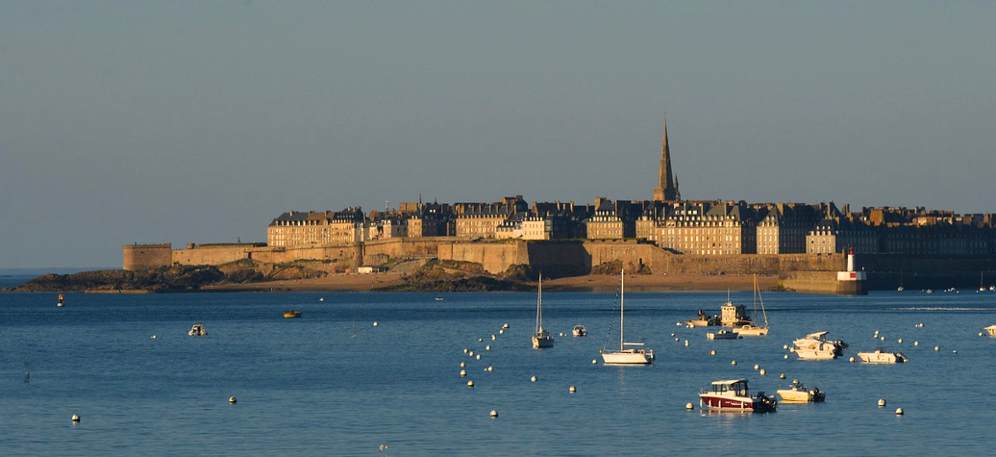
Brittany's tourist attractions
The Gitelink guide to Brittany - 2025
| ON THIS PAGE ► | Main attractions | The Brittany coast | Boats & sailing | Events & more |
Welcome to Brittany - France's Celtic fringe
Brittany's greatest tourist attractions are undoubtedly its beaches, coastal walks, rocky shoreline and small fishing harbours; but beyond this the region has an impressive collection of sites that are worth a visit, for their historic or culturalvalue, or just because they are really worth seeing.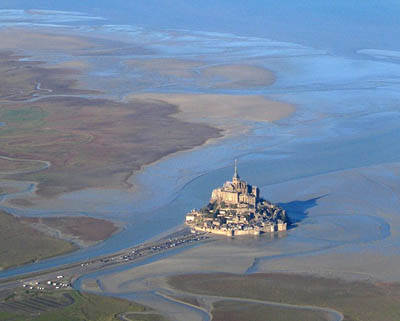 Le Mont Saint Michel
Le Mont Saint MichelIn the olden days, the mount stood in the midst of quicksands and moving water courses, and access to it was treacherous; the causeway that now carries tourists and pilgrims across the bay was built in 1880, and its construction led to a heavy silting up of the area round the mount, transforming much of the bay into grazing lands. There are currently plans to turn the clocks back, and remove the causeway, so that the sea can once again come in and wash right round the mount.
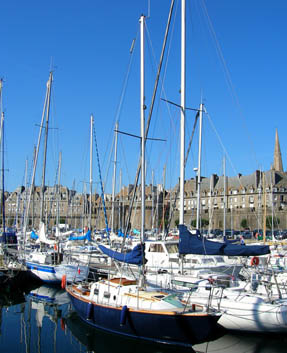 Saint Malo
Saint MaloThe most visited town in Brittany, St Malo is, like the Mont St. Michel, a fortified enclave standing on a peninsula at the mouth of a river. The city grew up many centuries ago at the mouth of the river Rance, and became famous as the home of adventurers and pirates. Jacques Cartier - the man who discovered Canada - came from St. Malo, but so too did the privateers and corsairs who for centuries preyed on shipping rounding the western tip of France.
Built in the local grey granite, St Malo has a historic centre crammed in behind its ramparts which owe their current form to the great French XVIIth century military architect, Vauban. A large part of the historic heart was severely damaged by action during the second world war, but has been carefully renovated to its former glory. The city has a number of interesting places to visit, notably the Cape Horn museum devoted to the mariner-explorers of the past, the aquarium, and the castle - known as the Bastille of the west - which has exhibits about the city's history and its pirates.
The Brittany coast
With over 2700 km of coastline, Brittany has something for everyone. In the northeast, between Mont Saint Michel and Cancale, there are large wide sandy beaches, popular for land-yachting. At low tide, it can be quite a walk to the water's edge. From Cancale westwards, the coast is rocky, with small sandy beaches and inlets. The Pink Granite Coast, between Paimpol and Perros Guirec is particularly pretty.The western tips of Brittany are wild headlands jutting out into the Atlantic (see la Pointe du Raz below). The south coast of Brittany - though facing out onto the Bay of Biscay - has plenty of long sandy beaches, as well as small fishing ports. The south east coast of the Morbihan, with its sheltered inlets, is particularly popular with yachtsmen, and La Trinité sur Mer is a very popular yachting harbour.
La Pointe du Raz and the tips of Brittany
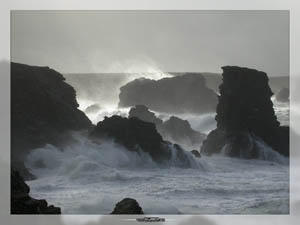 France's
"Land's End", the Pointe du Raz is the most westerly point of the
French mainland, the end of Cape Sizun , which forms the westerly tip
of the department of Finistère (which means the End of the
Earth - or Land's End).
France's
"Land's End", the Pointe du Raz is the most westerly point of the
French mainland, the end of Cape Sizun , which forms the westerly tip
of the department of Finistère (which means the End of the
Earth - or Land's End). After decades of over-exploitation, operation of the area was handed over to a nature conservancy organisation, with a remit to return the area to its natural state and manage it as an environmentally sensitive area. Many of the buildings that once disfigured the site have been demolished, and today a new visitor centre has been built near the car park, which is weel away from the point. Visitors can either walk from there, or take the gas-powered shuttle bus. The area of the Pointe du Raz is now served by a network of managed footpaths, allowing visitors to admire this exceptional natural site, and the Atlantic waves crashing onto the rocks below.
Inland Brittany - Monts d'Arrée and Montagne Noire.
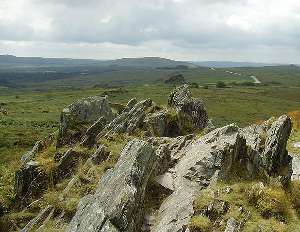 The
Monts d'Arrée, forming alarge part of the Armorique
Regional Park in
Finistère, are the wildest and highest part of Brittany,
culminating at
Roch Trévézel, an altitude of 384 metres and the
second highest point
in Brittany. This part of Brittany is very similar to Dartmoor or parts
of Wales, both in terms of landscape and outdoor opportunities. An area
of moorland, with rocky outcrops, heather and bracken and grassland, it
offers plenty of opportunities for hiking, mountain biking and horse
riding. The Montagne Noire, in the south of Finistère, is a
more wooded
area, but has plenty of hiking trails and opportunities for outdoor
pursuits, and also the western section of the Nantes Brest canal.
The
Monts d'Arrée, forming alarge part of the Armorique
Regional Park in
Finistère, are the wildest and highest part of Brittany,
culminating at
Roch Trévézel, an altitude of 384 metres and the
second highest point
in Brittany. This part of Brittany is very similar to Dartmoor or parts
of Wales, both in terms of landscape and outdoor opportunities. An area
of moorland, with rocky outcrops, heather and bracken and grassland, it
offers plenty of opportunities for hiking, mountain biking and horse
riding. The Montagne Noire, in the south of Finistère, is a
more wooded
area, but has plenty of hiking trails and opportunities for outdoor
pursuits, and also the western section of the Nantes Brest canal.Boat
trips
A visit to Brittany would be incomplete without a boat trip.There are a dozen or more accessible islands off the Brittany coast, and most of these can be reached for a day-trip from the nearest ports.
In Finistere, there are boats to Ouessant and the Ile de Sein from Brest or Audierne. Or trips to the tiny Iles Glénan are avaialble at Concarneau. On the north coast, the Ile de Batz can be reached by boat from Roscoff.
In the Morbihan, there are ferries from Quiberon to Belle Ile en Mer, the largest of the Breton islands, and ferries to the little Ile de Groix from Lorient.
In Côtes d'Armor, bird-watchers will not want to miss a trip to the Sept-Iles, just off the coast from Perros-Guirec, an important nature reserve for sea birds.
In Ille et Vilaine, and eastern Morbihan those who prefer a calm inland waterway to the possibility of being tossed on the Atlantic waves, can take river or canal cruises.
On the river Rance, near Dinard and St. Malo, cruises allow visitors to see the famous Rance tidal hydroelectric plant, the world's original full-scale tidal power-generation unit, opened in 1966.
In Arzal, Morbihan, there are boat trips on the river Vilaine, and in la Gacilly, near Redon, small cabin cruisers can be hired for a day's or an afternoon's excursion.
Brittany has some 600 kilometres of navigable waterways, and self-drive boats can be hired in many locations.
Main Festivals & events in Brittany 2025
The annual Lorient Interceltiques Festival (1st - 10th August 2025) is one of France's biggest international festivals. Morbihan, south Brittany.For more details, see the Celtic heritage page.
The Vieilles Charrues festival (17th to 20th July 2025) takes place each year in July near Carhaix, Finistère. Started in 1992, this open air music festival has rapidly established itself as the French equivalent of Glastonbury, and is now the biggest open air music event in France, attracting an eclectic variety of top musicians from France and abroad.
The Festival de Cornouaille ( July 2025) Quimper, Finistère; Brittany's biggest annual festival of Breton culture. The annual parade will take place on Sunday 28th July
The Fête des filets Bleus (the Blue Fish Nets festival) (13th - 17th August 2025) in Concarneau (Finistère). An opportunity to see the old streets of this fishing port filled with people in traditional Breton costume, and see traditional Breton dancing to the sound of traditional music. The festival first took place in 1905 !
Classical music in Brittany. There is no major classical music festival in Brittany, but many small festivals : more information on Classique-Bretagne
Tourist towns in Brittany and other various tourist attractions:
Brest: Oceanopolis - Fifty aquariums, divided into three climatic zones, and stocked with over 1000 varieties of fish and marine life from the polar regions, temperate zones and the tropics. The city of Brest is one of France's main naval ports - a bit like Plymouth in the UK. ► Website
Cornouailles Botanical Gardens - Combrit / Pont l'Abbé, Finistère. Extensive botanical gardens and arboretum, stocked with 3500 plant varieties from all over the world.
Celtic Brittany
Brittany is famous for its ancient monuments, the most famous of which are the standing stones of Carnac (photo left / below). See The Celtic Tradition
Concarneau (Finistère)
One of the great traditional Breton fishing ports - all the atmosphere of a traditional Breton port.
Dinan (near Saint Malo)
One of the most visited historic towns in Brittany, with ramparts, old streets and old houses, plus plenty of tourist boutiques.
Dinard (near St. Malo)
Popular and well established seaside resort on the "Emerald coast"
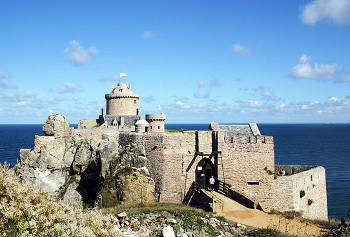 Fort
la Latte, on the north Brittany coast
Fort
la Latte, on the north Brittany coastHistoric fortress clinging to a rocky headland jutting out into the ocean; the castle dates from the 14th to the 18th centuries. Plenty to explore.
Fougères (Eastern Brittany)
Old walled town with, ramparts, an impressive castle, and attractive historic centre.
Josselin (Morbihan).
Attractive old town, with a magnificent chateau, with gardens and a doll museum.
Pleugueneuc, Château and zoo de La Bourbansais, (Ille et Vilaine); located in the grounds of a chateau, which can also be visited, the zoo, involved in the protection of endangered species, has a wide collection of animals from different continents. The giraffes are particularly popular.
Pointe du Raz A "grand site de France " - the westerly point of the French mainland, at the end of Cape Sizun , which forms the westerly tip of the department of Finistère (which means the End of the Earth - or Land's End).
Quiberon (Morbihan)
At the end of a long and very narrow isthmus, Quiberon stands as on an island in the gulf of Morbihan. It is an attractive small town, with port, plenty of beaches, and boat trips to the islands.
Nantes-Brest canal
Though it no longer links the two cities, the canal, running westwards from Redon, is an attractive trail for boating, hiking or cycling. The canal (and rivers that form part of the waterway) is navigable from Pontivy to Nantes, via Josselin and Redon.
Saint Malo
Fine walled and fortified granite city at the mouth of the river Rance - the most visited city in Brittany - once the home of explorers and pirates, now more popular with yachtsmen.
 A Gitelink
guide
A Gitelink
guide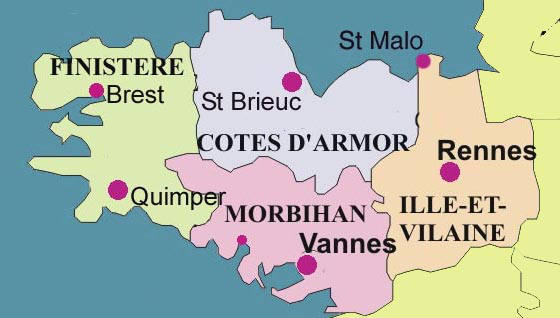
Selected places to stay
What better way to soak in the true flavour of Brittany, than by staying in one of the region's many gites villas or country cottages - many with English speaking owners. Gites and cottages offer a safe environment, just for you or your group► Cotes d'Armor and Finistère areas
► Morbihan and Ille et Vilaine areas
or check out Brittany gites on the Brittany gites map
Book directly with owners for best rates, peace of mind, and no extra fees
Picture top: St Malo in the setting sun
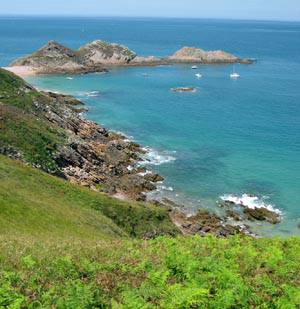
Côtes d'Armor

Quiberon
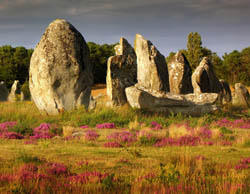
Carnac - prehistoric standing stones
Other accommodation
| Bed & Breakfast in Brittany |
| Traditional small hotels in Brittany |
| Hotels beside the sea in Brittany |
| Brittany tourist office |
| Small campsites in Brittany |
Copyright Gitelink.com 2003 - 2024 .
Photo top of page : Creative commons photo by Thesupermat
| More regional guides |
| Guide to Provence |
| Guide to the Auvergne |
| Guide to Languedoc-Roussillon |
| Other regions of France |
